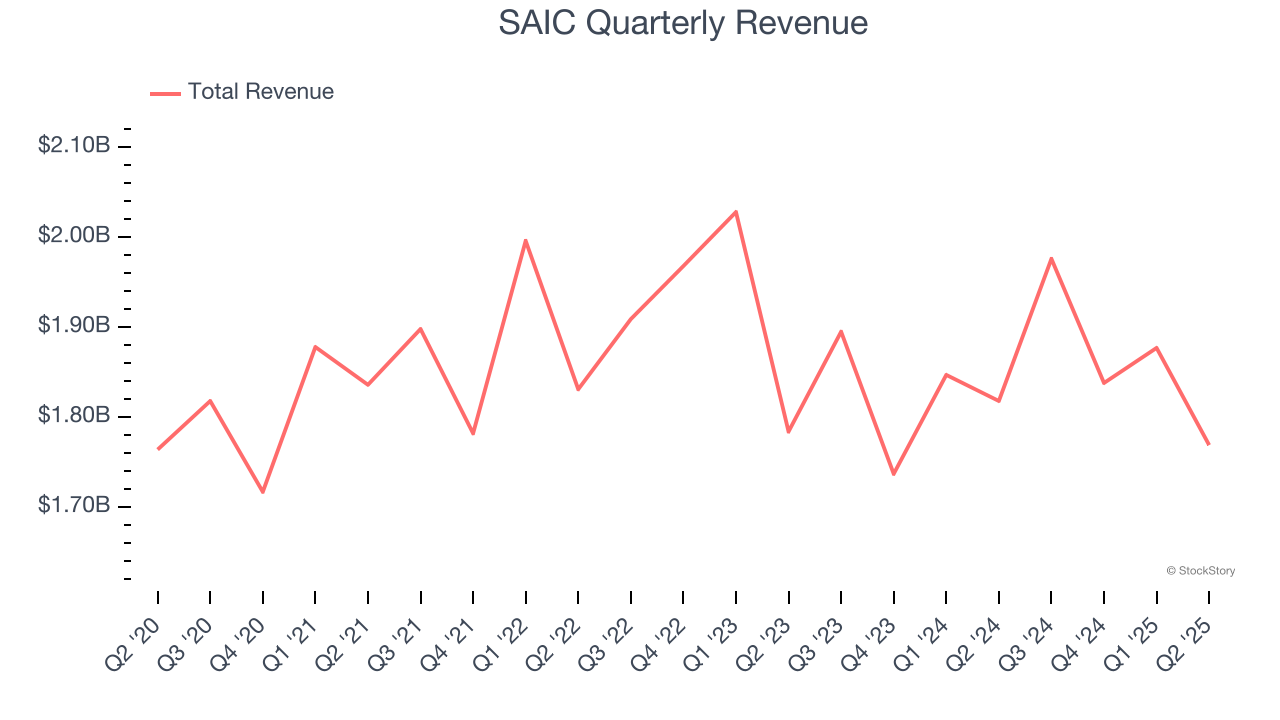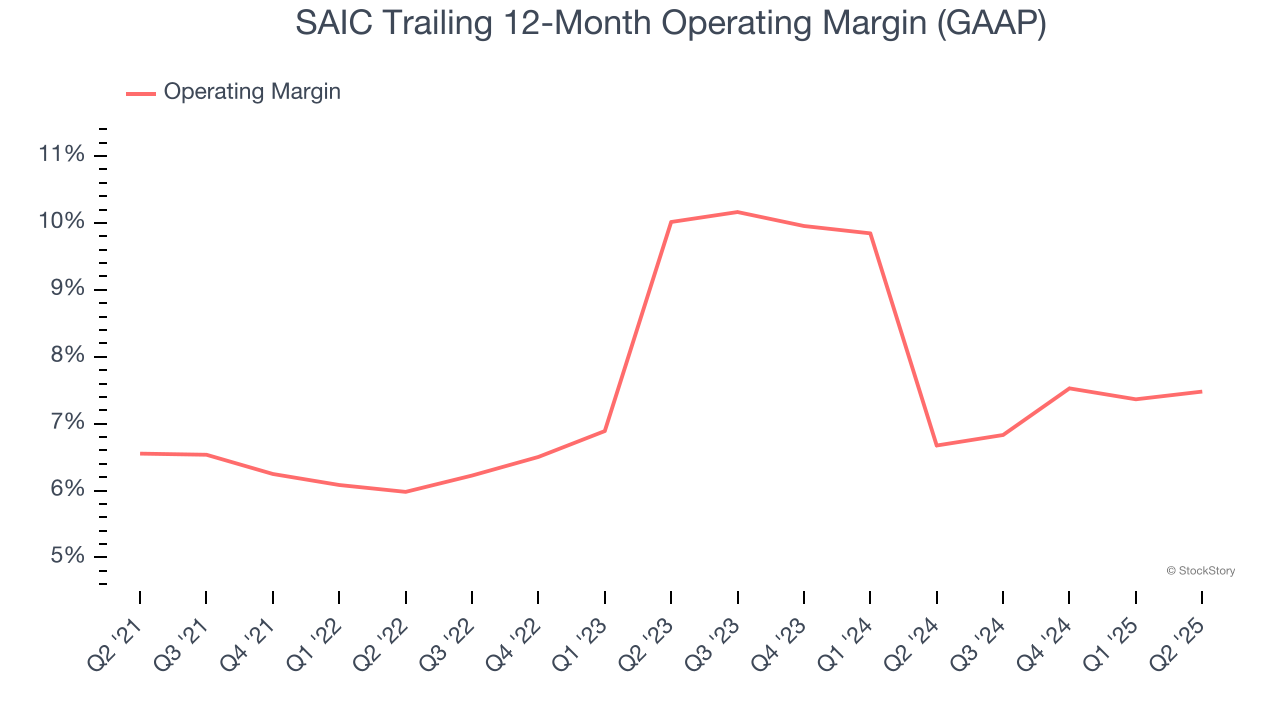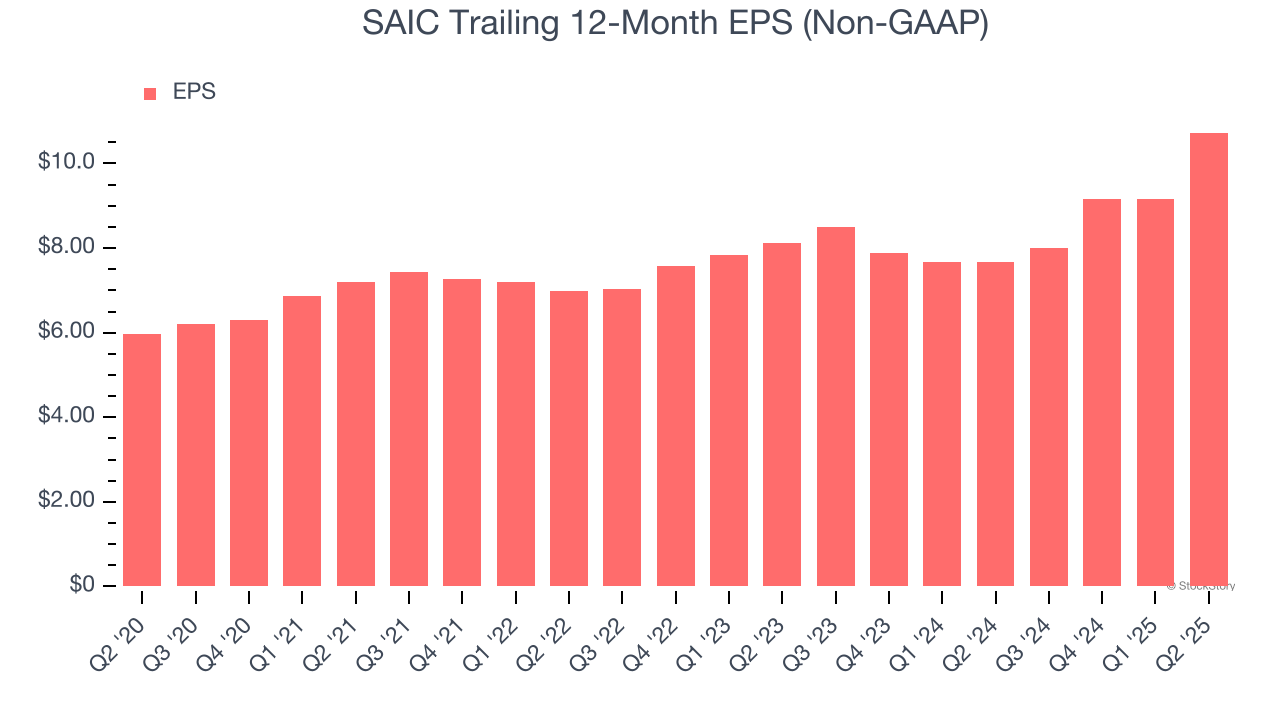
Government IT services provider Science Applications International Corporation (NASDAQ: SAIC) fell short of the market’s revenue expectations in Q2 CY2025, with sales falling 2.7% year on year to $1.77 billion. The company’s full-year revenue guidance of $7.29 billion at the midpoint came in 4.7% below analysts’ estimates. Its non-GAAP profit of $3.63 per share was 62.3% above analysts’ consensus estimates.
Is now the time to buy SAIC? Find out by accessing our full research report, it’s free.
SAIC (SAIC) Q2 CY2025 Highlights:
- Revenue: $1.77 billion vs analyst estimates of $1.86 billion (2.7% year-on-year decline, 5.1% miss)
- Adjusted EPS: $3.63 vs analyst estimates of $2.24 (62.3% beat)
- Adjusted EBITDA: $185 million vs analyst estimates of $178 million (10.5% margin, 3.9% beat)
- The company dropped its revenue guidance for the full year to $7.29 billion at the midpoint from $7.68 billion, a 5% decrease
- Management raised its full-year Adjusted EPS guidance to $9.50 at the midpoint, a 3.3% increase
- EBITDA guidance for the full year is $685 million at the midpoint, below analyst estimates of $719.4 million
- Operating Margin: 7.9%, in line with the same quarter last year
- Free Cash Flow Margin: 8.5%, down from 13.3% in the same quarter last year
- Backlog: $23.17 billion at quarter end
- Market Capitalization: $5.35 billion
Company Overview
With over five decades of experience supporting national security missions, Science Applications International Corporation (NASDAQ: SAIC) provides technical, engineering, and enterprise IT services primarily to U.S. government agencies and military branches.
Revenue Growth
Reviewing a company’s long-term sales performance reveals insights into its quality. Even a bad business can shine for one or two quarters, but a top-tier one grows for years.
With $7.46 billion in revenue over the past 12 months, SAIC is one of the larger companies in the business services industry and benefits from a well-known brand that influences purchasing decisions. However, its scale is a double-edged sword because it’s harder to find incremental growth when you’ve penetrated most of the market. To accelerate sales, SAIC likely needs to optimize its pricing or lean into new offerings and international expansion.
As you can see below, SAIC’s sales grew at a sluggish 2.2% compounded annual growth rate over the last five years. This shows it failed to generate demand in any major way and is a rough starting point for our analysis.

We at StockStory place the most emphasis on long-term growth, but within business services, a half-decade historical view may miss recent innovations or disruptive industry trends. SAIC’s performance shows it grew in the past but relinquished its gains over the last two years, as its revenue fell by 1.5% annually. 
This quarter, SAIC missed Wall Street’s estimates and reported a rather uninspiring 2.7% year-on-year revenue decline, generating $1.77 billion of revenue.
Looking ahead, sell-side analysts expect revenue to grow 3.7% over the next 12 months. While this projection implies its newer products and services will spur better top-line performance, it is still below the sector average.
Today’s young investors won’t have read the timeless lessons in Gorilla Game: Picking Winners In High Technology because it was written more than 20 years ago when Microsoft and Apple were first establishing their supremacy. But if we apply the same principles, then enterprise software stocks leveraging their own generative AI capabilities may well be the Gorillas of the future. So, in that spirit, we are excited to present our Special Free Report on a profitable, fast-growing enterprise software stock that is already riding the automation wave and looking to catch the generative AI next.
Operating Margin
SAIC’s operating margin might fluctuated slightly over the last 12 months but has generally stayed the same, averaging 7.4% over the last five years. This profitability was paltry for a business services business and caused by its suboptimal cost structure.
Analyzing the trend in its profitability, SAIC’s operating margin might fluctuated slightly but has generally stayed the same over the last five years. This raises questions about the company’s expense base because its revenue growth should have given it leverage on its fixed costs, resulting in better economies of scale and profitability.

This quarter, SAIC generated an operating margin profit margin of 7.9%, in line with the same quarter last year. This indicates the company’s overall cost structure has been relatively stable.
Earnings Per Share
We track the long-term change in earnings per share (EPS) for the same reason as long-term revenue growth. Compared to revenue, however, EPS highlights whether a company’s growth is profitable.
SAIC’s EPS grew at a remarkable 12.4% compounded annual growth rate over the last five years, higher than its 2.2% annualized revenue growth. This tells us the company became more profitable on a per-share basis as it expanded.

Like with revenue, we analyze EPS over a shorter period to see if we are missing a change in the business.
For SAIC, its two-year annual EPS growth of 14.9% was higher than its five-year trend. We love it when earnings growth accelerates, especially when it accelerates off an already high base.
In Q2, SAIC reported adjusted EPS of $3.63, up from $2.05 in the same quarter last year. This print easily cleared analysts’ estimates, and shareholders should be content with the results. Over the next 12 months, Wall Street expects SAIC’s full-year EPS of $10.73 to shrink by 8.7%.
Key Takeaways from SAIC’s Q2 Results
It was good to see SAIC beat analysts’ EPS expectations this quarter. We were also glad its full-year EPS guidance outperformed Wall Street’s estimates. On the other hand, its full-year revenue guidance missed and its revenue fell short of Wall Street’s estimates. Zooming out, we think this was a mixed quarter. Investors were likely hoping for more, and shares traded down 1.9% to $111.70 immediately following the results.
Should you buy the stock or not? If you’re making that decision, you should consider the bigger picture of valuation, business qualities, as well as the latest earnings. We cover that in our actionable full research report which you can read here, it’s free.





